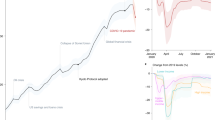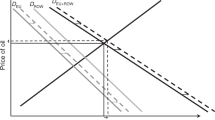Abstract
The Russia–Ukraine conflict lays bare the dependence of the European Union (EU) on fossil fuel imports from Russia. Here, we use a global computable general equilibrium model, C3IAM/GEEPA, to estimate CO2 emission and gross domestic product (GDP) impact of embargoing fossil fuels from Russia. We find that embargoes induce more than 10% reduction of CO2 emissions in the EU and over 5% increases of emissions in Russia, while both regions experience GDP losses (around 2% (US $486 billion) for the EU and about 5% (US $149 billion) for Russia, ignoring the relative impact of other sanctions). Reacting to increasing energy prices with demand-side response inside the EU would increase CO2 emission savings, and ease GDP losses; however, the world would continue to suffer economic damage (US $655 billion).
This is a preview of subscription content, access via your institution
Access options
Access Nature and 54 other Nature Portfolio journals
Get Nature+, our best-value online-access subscription
$29.99 / 30 days
cancel any time
Subscribe to this journal
Receive 12 print issues and online access
$209.00 per year
only $17.42 per issue
Buy this article
- Purchase on Springer Link
- Instant access to full article PDF
Prices may be subject to local taxes which are calculated during checkout





Similar content being viewed by others
Data availability
The data that support the plots within this paper and other findings of this study are available from the corresponding authors upon reasonable request.
Code availability
The codes that support the methods of this study are available from the corresponding authors upon reasonable request.
Change history
21 April 2023
Since publication of this article, sections of main text have been slightly modified to clarify intended meaning and to frame economic effects in US dollar terms.
References
Russia—Countries & Regions (IEA, 2022); https://www.iea.org/countries/russia
Europe is a Key Destination for Russia’s Energy Exports (IEA, 2022); https://www.eia.gov/todayinenergy/detail.php?id=51618
IPCC Summary for Policymakers. In Climate Change 2022: Mitigation of Climate Change (eds Shukla, P. R. et al.) 4–48 (Cambridge Univ. Press, 2022).
Bachmann, R. et al. What if? The Economic Effects for Germany of a Stop of Energy Imports from Russia (CESifo Network, 2022).
Evenett, S. J. & Muendler, M.-A. Making Moscow Pay. How Much Extra Bite Will G7 & EU Trade Sanctions Have? (UC San Diego, 2022).
Halser, C. & Paraschiv, F. Pathways to overcoming natural gas dependency on Russia—the German case. Energies 15, 4939 (2022).
Chepeliev, M., Hertel, T. W. & van der Mensbrugghe, D. Cutting Russia’s Fossil Fuel Exports: Short-term Pain for Long-term Gain (SSRN, 2022).
Creutzig, F. Fuel crisis: slash demand in three sectors to protect economies and climate. Nature 606, 460–462 (2022).
Trade Map—Trade Statistics for International Business Development (ITC, 2022); https://www.trademap.org/Index.aspx
Energy Fact Sheet: Why Does Russian Oil and Gas Matter? (IEA, 2022); https://www.iea.org/articles/energy-fact-sheet-why-does-russian-oil-and-gas-matter
Creutzig, F. et al. in Climate Change 2022: Mitigation of Climate Change (eds Shukla, P. R. et al.) 752–943 (IPCC, Cambridge Univ. Press, 2022).
Council Adopts Regulation on Reducing Gas Demand by 15% this Winter (Council of the EU, 2022); https://www.consilium.europa.eu/en/press/press-releases/2022/08/05/council-adopts-regulation-on-reducing-gas-demand-by-15-this-winter/
Karanassou, M. & Snower, D. J. How labour market flexibility affects unemployment: long-term implications of the chain reaction theory. Econ. J. 108, 832–849 (1998).
McDonald, I. M. & Solow, R. M. Wage bargaining and employment. Am. Econ. Rev. 71, 896–908 (1981).
Wei, Y.-M. et al. An integrated assessment of INDCs under Shared Socioeconomic Pathways: an implementation of C3IAM. Nat. Hazard 92, 585–618 (2018).
Wei, Y.-M. et al. Pathway comparison of limiting global warming to 2 °C. Energy Clim. Change 2, 100063 (2021).
Liu, L.-J., Creutzig, F., Yao, Y.-F., Wei, Y.-M. & Liang, Q.-M. Environmental and economic impacts of trade barriers: the example of China–US trade friction. Resour. Energy Econ. 59, 101144 (2020).
Liu, L.-J. et al. Combining economic recovery with climate change mitigation: a global evaluation of financial instruments. Econ. Anal. Policy 72, 438–453 (2021).
Jiang, H.-D., Purohit, P., Liang, Q.-M., Dong, K. & Liu, L.-J. The cost–benefit comparisons of China’s and India’s NDCs based on carbon marginal abatement cost curves. Energy Econ. 109, 105946 (2022).
Aguiar, A., Narayanan, B. & McDougall, R. An overview of the GTAP 9 data base. J. Glob. Econ. Anal. 1, 181–208 (2016).
Model Documentation—C3IAM (IAMC, 2021); https://www.iamcdocumentation.eu/index.php/Model_Documentation_-_C3IAM
Nguyen, T. B., Wagner, F. & Schoepp, W. in Information and Communication on Technology for the Fight Against Global Warming (eds Kranzlmüller, D. & Toja, A. M.) 124–135 (Springer, 2011).
O’Neill, B. C. et al. The roads ahead—narratives for shared socioeconomic pathways describing world futures in the 21st century. Glob. Environ. Change 42, 169–180 (2017).
Gidden, M. J. et al. Global emissions pathways under different socioeconomic scenarios for use in CMIP6: a dataset of harmonized emissions trajectories through the end of the century. Geosci. Model Dev. 12, 1443–1475 (2019).
Jiang, H.-D., Xue, M.-M., Dong, K.-Y. & Liang, Q.-M. How will natural gas market reforms affect carbon marginal abatement costs? Evidence from China. Econ. Syst. Res. 34, 129–150 (2021).
Xue, M.-M., Wu, G., Wang, Q., Yao, Y.-F. & Liang, Q.-M. Socioeconomic impacts of a shortage in imported oil supply: case of China. Nat. Hazards 99, 1415–1430 (2019).
Acknowledgements
We gratefully acknowledge the financial support of the National Natural Science Foundation of China (grant nos. 72074022, 72104022, 72293600 and 72204234). We thank our colleagues for their support and acknowledge help from CEEP-BIT.
Author information
Authors and Affiliations
Contributions
Q.-M.L., F.C. and Y.-M.W. conceptualized the paper. L.-J.L., H.-D.J., J.Q. and Q.-R.C. acquired the data. L.-J.L., H.-D.J. and Q.-M.L. carried out the model. L.-J.L., H.-D.J., Q.-M.L., F.C., H.L., Y.-F.Y., Z.-Y.R., O.E. and Y.-M.W. contributed to the interpretation of the results. L.-J.L., H.-D.J., Q.-M.L., F.C. and X.Y.Q. implemented the data presentation and visualization. L.-J.L., H.-D.J., Q.-M.L. and F.C. contributed to the Supplementary Information. L.-J.L., H.-D.J., Q.-M.L., F.C. and Y.-M.W. wrote and reviewed the main manuscript.
Corresponding authors
Ethics declarations
Competing interests
The authors declare no competing interests.
Peer review
Peer review information
Nature Climate Change thanks Thomas Longden, Giacomo Marangoni and Ashwin Rode for their contribution to the peer review of this work.
Additional information
Publisher’s note Springer Nature remains neutral with regard to jurisdictional claims in published maps and institutional affiliations.
Extended data
Extended Data Fig. 1 The framework of C3IAM/GEEPA.
C3IAM/GEEPA is a multiregional recursive dynamic computable general equilibrium (CGE) model, which is composed of production, income/expenditure, investment and foreign trade. When producing one commodity, labour, capital, energy and other intermediate products are all inputs in each sector, which are assumed to follow a nested constant elasticity of substitute (CES) function. Household income mainly comes from labour income and capital returns; Government income is composed of tariff, indirect tax, household income tax and transfers from other countries/regions. C3IAM/GEEPA adopts Armington assumption, assuming there is imperfect substitutability between imports and domestic output sold domestically. The commodity that supplied domestically is composed of domestic and imported commodities following a CES function. A constant elasticity transformation (CET) function is used to allocate total domestic output between exports and domestic sales. The commodity, capital, and labour markets are cleared in C3IAM/GEEPA. The model adopts the recursive dynamic mechanism and is pushed forward through capital accumulation, population growth, and improvement of total factor productivity.
Supplementary information
Supplementary Information
Supplementary Results (1 and 2), uncertainty analysis (3 and 4) and model introduction (5 and 6).
Rights and permissions
Springer Nature or its licensor (e.g. a society or other partner) holds exclusive rights to this article under a publishing agreement with the author(s) or other rightsholder(s); author self-archiving of the accepted manuscript version of this article is solely governed by the terms of such publishing agreement and applicable law.
About this article
Cite this article
Liu, LJ., Jiang, HD., Liang, QM. et al. Carbon emissions and economic impacts of an EU embargo on Russian fossil fuels. Nat. Clim. Chang. 13, 290–296 (2023). https://doi.org/10.1038/s41558-023-01606-7
Received:
Accepted:
Published:
Issue Date:
DOI: https://doi.org/10.1038/s41558-023-01606-7



